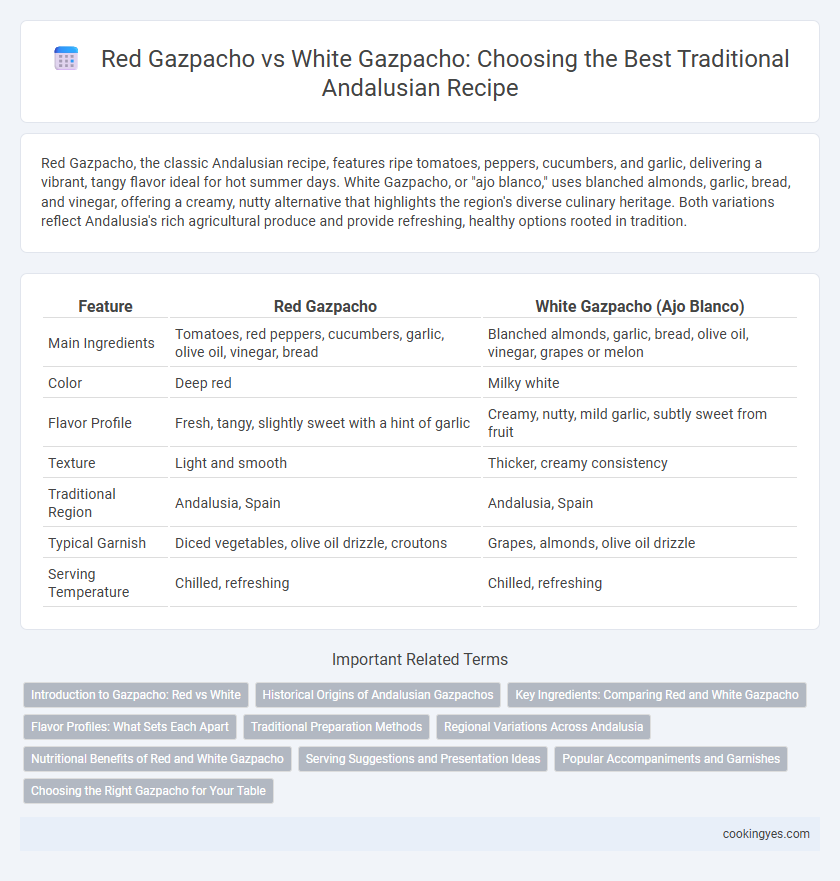Red Gazpacho, the classic Andalusian recipe, features ripe tomatoes, peppers, cucumbers, and garlic, delivering a vibrant, tangy flavor ideal for hot summer days. White Gazpacho, or "ajo blanco," uses blanched almonds, garlic, bread, and vinegar, offering a creamy, nutty alternative that highlights the region's diverse culinary heritage. Both variations reflect Andalusia's rich agricultural produce and provide refreshing, healthy options rooted in tradition.
Table of Comparison
| Feature | Red Gazpacho | White Gazpacho (Ajo Blanco) |
|---|---|---|
| Main Ingredients | Tomatoes, red peppers, cucumbers, garlic, olive oil, vinegar, bread | Blanched almonds, garlic, bread, olive oil, vinegar, grapes or melon |
| Color | Deep red | Milky white |
| Flavor Profile | Fresh, tangy, slightly sweet with a hint of garlic | Creamy, nutty, mild garlic, subtly sweet from fruit |
| Texture | Light and smooth | Thicker, creamy consistency |
| Traditional Region | Andalusia, Spain | Andalusia, Spain |
| Typical Garnish | Diced vegetables, olive oil drizzle, croutons | Grapes, almonds, olive oil drizzle |
| Serving Temperature | Chilled, refreshing | Chilled, refreshing |
Introduction to Gazpacho: Red vs White
Red gazpacho, a traditional Andalusian cold soup, features ripe tomatoes combined with cucumbers, bell peppers, garlic, olive oil, vinegar, and stale bread for a refreshing, vibrant flavor. White gazpacho, also known as ajo blanco, emphasizes blanched almonds, bread, garlic, olive oil, and grapes or melon, offering a creamy and nutty alternative without tomatoes. Both variations highlight Andalusia's culinary heritage, showcasing regional ingredients and contrasting textures in cold soups.
Historical Origins of Andalusian Gazpachos
Red gazpacho, known as "gazpacho rojo," originated from the combination of ripe tomatoes, red peppers, cucumbers, and garlic, reflecting the Moorish influence on Andalusian cuisine dating back to the medieval period. White gazpacho, or "ajo blanco," is a traditional almond and garlic-based cold soup with roots in Roman times, showcasing the region's ancient agricultural practices and preference for mild flavors. Both varieties illustrate the historical fusion of Mediterranean and North African culinary traditions that shaped Andalusia's rich gastronomic heritage.
Key Ingredients: Comparing Red and White Gazpacho
Red gazpacho features ripe tomatoes, red bell peppers, cucumbers, garlic, olive oil, vinegar, and stale bread, creating a vibrant, tangy flavor profile. White gazpacho, or ajo blanco, replaces tomatoes with blanched almonds, garlic, bread, olive oil, vinegar, and often includes green grapes or melon for a creamy, slightly sweet taste. Both variations emphasize fresh, high-quality Andalusian ingredients, showcasing regional agricultural staples in their traditional cold soup recipes.
Flavor Profiles: What Sets Each Apart
Red Gazpacho features ripe tomatoes, red peppers, and cucumbers, creating a bold, tangy, and refreshing flavor with a vibrant color. White Gazpacho, made from almonds, garlic, bread, and olive oil, offers a creamy, nutty, and milder taste with a smooth texture. Traditional Andalusian recipes highlight red gazpacho's bright acidity and spice, while white gazpacho emphasizes subtle richness and delicate flavor.
Traditional Preparation Methods
Red Gazpacho, rooted in traditional Andalusian recipes, relies heavily on ripe tomatoes, cucumbers, green peppers, garlic, olive oil, vinegar, and stale bread blended into a refreshing cold soup. White Gazpacho, or "ajo blanco," omits tomatoes and instead incorporates blanched almonds, garlic, stale bread, olive oil, vinegar, and sometimes melon or grapes for sweetness, emphasizing a nutty and creamy texture. Both versions require meticulous soaking and blending techniques to achieve authentic smoothness, with emphasis on fresh, locally sourced ingredients to preserve traditional flavors.
Regional Variations Across Andalusia
Red Gazpacho, traditionally made with ripe tomatoes, cucumbers, peppers, garlic, and olive oil, reflects the coastal influences of Malaga and Cadiz, where the use of vibrant, sun-ripened vegetables is prominent. White Gazpacho, or Ajo Blanco, primarily found in the provinces of Malaga and Granada, emphasizes blanched almonds, garlic, and bread, offering a creamier texture and a subtler, nutty flavor profile. These regional variations highlight Andalusia's diverse agricultural outputs and culinary traditions, with Red Gazpacho popular along the Atlantic coast and White Gazpacho rooted more inland.
Nutritional Benefits of Red and White Gazpacho
Red Gazpacho, made primarily with tomatoes, offers high levels of lycopene, vitamin C, and antioxidants that support heart health and skin vitality. White Gazpacho, featuring ingredients like almonds, garlic, and bread, provides essential healthy fats, protein, and minerals such as magnesium and calcium, promoting bone strength and sustained energy. Both traditional Andalusian variants deliver hydrating properties and essential nutrients while catering to different dietary needs and flavor preferences.
Serving Suggestions and Presentation Ideas
Red Gazpacho, made with ripe tomatoes, red peppers, cucumbers, and garlic, is traditionally served chilled in rustic bowls garnished with diced vegetables, hard-boiled eggs, or thinly sliced ham for a vibrant, colorful presentation. White Gazpacho, also known as ajo blanco, features blanched almonds, garlic, bread, and grapes, often presented in elegant glasses topped with green grapes or melon balls to highlight its creamy texture and subtle flavors. Both versions benefit from chilled serving and fresh herb sprigs like parsley or mint to enhance aroma and visual appeal in traditional Andalusian settings.
Popular Accompaniments and Garnishes
Red Gazpacho commonly features accompaniments such as diced cucumbers, bell peppers, and crusty bread croutons that enhance its rich tomato base. Traditional White Gazpacho, or Ajo Blanco, is often garnished with grapes, almonds, and thin slices of jamon serrano to complement its almond and garlic flavors. Both versions showcase unique garnishes that reflect Andalusian culinary traditions and elevate the sensory experience of this chilled soup.
Choosing the Right Gazpacho for Your Table
Red Gazpacho, made with ripe tomatoes, cucumbers, bell peppers, garlic, and olive oil, offers a rich, tangy flavor that pairs well with robust accompaniments like crusty bread or cured ham. White Gazpacho, also known as ajoblanco, features blanched almonds, garlic, bread, vinegar, and olive oil, resulting in a creamy, nutty profile ideal for lighter dishes or summer salads. Selecting the right gazpacho depends on balancing boldness and subtlety to complement your meal's ingredients and desired flavor experience.
Red Gazpacho vs White Gazpacho for traditional Andalusian recipes Infographic

 cookingyes.com
cookingyes.com